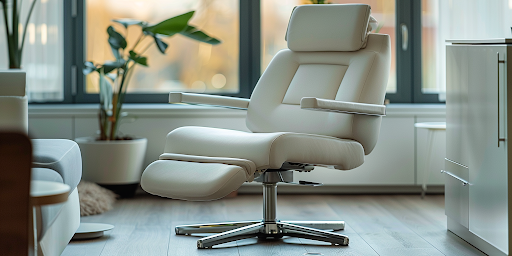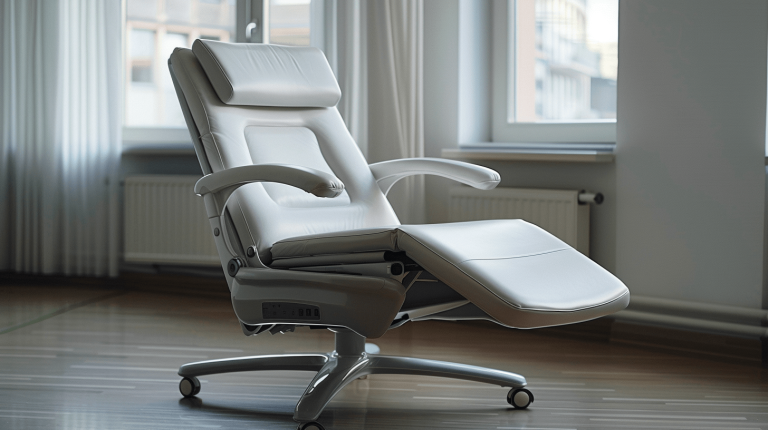Ensuring that clinical chairs can accommodate patients with different body sizes is more important than ever. From individuals with obesity to those with unique mobility challenges, healthcare facilities must prioritize seating solutions that provide comfort and safety for a wide range of body types. In this blog, we explain how modern clinical chairs are engineered to meet the needs of diverse patients, highlighting key features like weight capacity, adjustability, and ergonomic design.
The Role of Treatment Chairs in Patient-Centered Care
Designing healthcare environments to accommodate patients with diverse body sizes and mobility needs presents significant challenges. Traditional patient care environments often lack the flexibility and space necessary to support expanded-capacity furniture and equipment, which are crucial for providing adequate care for patients of varying sizes.
The Importance of Accommodating Different Body Sizes
Accommodating different body sizes is not just a matter of patient comfort—it is a fundamental aspect of clinical excellence. Clinical chairs designed for a range of patients offer adjustable features that ensure proper posture support and comfort during treatment. Whether dealing with an obese patient or a person with disabilities, the chair must provide consistent positioning and pressure relief to prevent discomfort during treatment and reduce the risk of injury.
What Are Clinical Chairs Used For?
How Do Medical Chairs Support Patients with Different Body Mass and Size?
Clinical chairs are designed with various features to support patients of different body masses and sizes, ensuring comfort, safety, and accessibility. These chairs often have adjustable components such as seat height, backrests, and armrests, allowing them to accommodate a wide range of body types and provide personalized support. Reinforced frames and high-weight capacities ensure stability and durability for heavier patients, while wider seats and extra padding enhance comfort for larger individuals.
Some clinical chairs also include motorized adjustments, making it easier for patients with limited mobility to get in and out of the chair safely. Bariatric models, in particular, are specifically designed for higher-weight patients, offering extra-wide seats and robust construction to provide a safe and comfortable experience. These adaptive features work together to ensure clinical chairs can cater to diverse patient needs, promoting a more inclusive healthcare environment.
Browse Different Clinical Chair Models
Benefits of Ergonomic Clinical Chairs
Manufacturing clinical chairs involves precise design considerations to meet diverse patient needs. Careful evaluation of elements like seat pads, arm supports, and riser recliners is crucial to provide adequate support and enhance patient comfort. The goal is to create seating that meets all design requirements, ensuring that seating solutions are safe, comfortable, and accessible for all patients, including those requiring special accommodations.
Improved Patient Satisfaction
When clinical chairs are designed to accommodate a wide range of body sizes, patients feel more comfortable and supported during their treatment. This leads to greater satisfaction, as patients are more likely to have a positive experience when they are seated comfortably and securely, without feeling cramped or unsupported.
Enhanced Accessibility for Patients
By accommodating patients of varying body sizes, including those with obesity or disabilities, clinical chairs ensure that healthcare services are accessible to all. This inclusivity is essential for delivering equitable care, where every patient, regardless of their size, feels valued and respected.
Reduced Risk of Injury and Discomfort
Clinical chairs that properly accommodate different body sizes help reduce the risk of discomfort during treatment and the likelihood of injuries. Patients who are seated comfortably are less likely to experience pressure sores or other issues related to improper seating, which can be particularly common among patients with larger body masses or those requiring longer treatment sessions.
Better Patient Outcomes
Accommodating patients with varying body sizes in clinical chairs contributes to better overall health outcomes. Comfortable patients are more likely to remain still during procedures, which can be critical for the accuracy of treatments or imaging. Additionally, proper seating supports good posture and positioning, which can enhance the effectiveness of treatments, particularly in physical rehabilitation or other therapeutic settings.
Increased Efficiency in Care
For caregivers, clinical chairs that accommodate different body sizes streamline patient transfers and other aspects of care, reducing the physical strain on staff. This leads to more efficient practices in healthcare facilities, allowing caregivers to focus more on patient interaction and less on managing logistical challenges.
Support for a Broader Range of Patients
Accommodating different body sizes means that healthcare facilities are better equipped to serve a broader range of patients, including those who might otherwise face barriers to accessing appropriate care. This inclusivity is especially important in environments with a high patient ratio, where the ability to provide individualized care can make a significant difference in patient satisfaction and outcomes.
Can Clinical Chairs Be Used for Home Care?
5 Key Features of Clinical Chairs for Diverse Body Sizes
1. Adjustable Seat Height and Depth
Adjustable seat height and seat depths are critical for ensuring that chairs can support patients of varying sizes. Chairs with these features can be adapted to suit individual patients, providing better posture support and reducing the risk of discomfort or injury during treatment sessions.
2. Increased Weight Capacity
Chairs that accommodate bariatric patients must have a high weight limit, often exceeding the standard capacity of traditional furnishings. Chairs with expanded-capacity thresholds are necessary to safely support obese patients, reducing the risk of accidents and improving patient outcomes.
3. Lateral Supports and Armrest Adjustability
Lateral supports and adjustable armrest height are essential for patients with mobility challenges or those who require additional assistance. These features help maintain consistent positioning, ensuring patient comfort and reducing the risk of pressure sores.
4. Ergonomic Design and Tilt Mechanisms
Ergonomic design is a fundamental element in clinical chairs, particularly for patients who spend extended periods seated. Features like posterior tilt and adjustable angles enhance comfort and allow for proper posture during treatment, which is crucial for patients with disabilities or those undergoing bariatric care.
5. Modular and Customizable Options
Clinical chairs with modular designs enable customization based on the specific needs of individual patients. This flexibility is vital in health care environments where patients’ requirements can vary significantly. For example, children with disabilities need specialized equipment that differs from the needs of an obese patient.
What Safety Features Do Clinical Chairs Have?
Integrating Clinical Chairs with Advanced Medical Equipment
The integration of clinical chairs with advanced medical equipment is a critical aspect of modern healthcare design. Not only do specialized chairs ensure that patients of various body sizes and conditions receive proper care but also enhance the overall efficiency and safety of medical procedures.
Clinical Chairs for X-Rays
X-ray procedures require patients to remain still and in precise positions to obtain accurate imaging results. Clinical X-ray chairs must provide comfortable positioning, even for patients of size or those with limited mobility. These chairs are built with reinforced structures and adhere to strict weight capacity guidelines to accommodate fat patients without compromising on stability or comfort. The inclusion of an integrated seat lift mechanism in these chairs allows for smooth and efficient positioning, reducing the need for additional caregivers to assist with patient transfers.
Mammography Chairs
Mammography exams can be particularly challenging for patients with larger body sizes or those who have difficulty standing for extended periods. Mammography chairs are designed to provide accommodation for a wide range of body types, ensuring that all patients can undergo the procedure comfortably and safely. These chairs feature adjustable seat heights and arm supports, allowing for precise positioning and minimizing discomfort during the exam.
Rehabilitation Therapy Chairs
Rehabilitation therapy often involves prolonged sessions where patients need to be positioned correctly to engage in exercises or receive treatment. Rehabilitation chairs are designed with advanced features such as auto-tilt mechanisms, posture support chairs, and adjustable seat belts to ensure that patients are comfortably secured during therapy sessions. These features are particularly important for persons with disabilities or those recovering from surgeries like bariatric surgery.
EMP Living: Adaptive Seating Solutions
Discover the ultimate in adaptive seating with EMP Living‘s innovative solutions. Our powered adaptive chairs are tailored to meet the diverse needs of individuals at home, work, and school. Whether you need inclusive seating for children or specialized clinical chairs for medical exams or rehab therapy, our customizable designs ensure that you stay comfortable and supported. EMP Living’s seating solutions empower you to do more, safely and independently.
Browse Our Powered Examination Chairs




